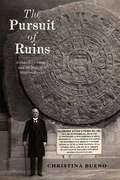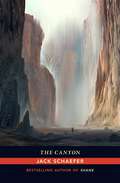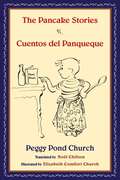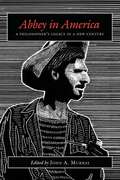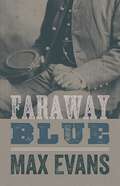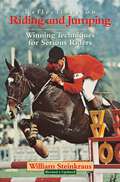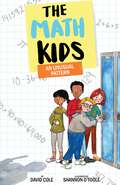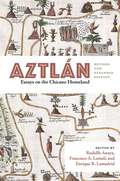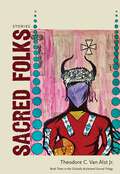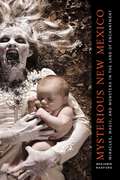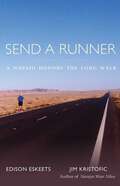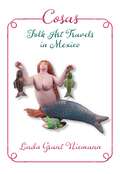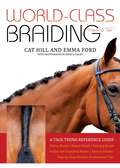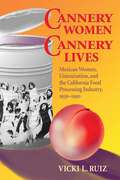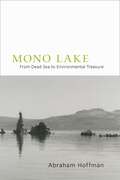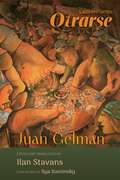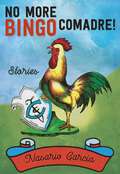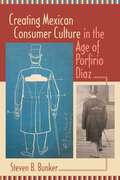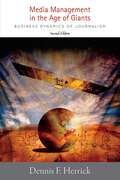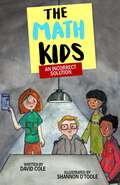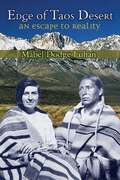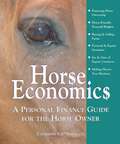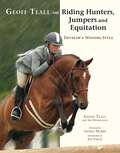- Table View
- List View
The Pursuit of Ruins: Archaeology, History, and the Making of Modern Mexico (Diálogos Series)
by Christina BuenoFamous for its majestic ruins, Mexico has gone to great lengths to preserve and display the remains of its pre-Hispanic past. The Pursuit of Ruins argues that the government effort to take control of the ancient remains took off in the late nineteenth century during the dictatorship of Porfirio Díaz. Under Díaz Mexico acquired an official history more firmly rooted in Indian antiquity. This prestigious pedigree served to counter Mexico&’s image as a backward, peripheral nation. The government claimed symbolic links with the great civilizations of pre-Hispanic times as it hauled statues to the National Museum and reconstructed Teotihuacán. Christina Bueno explores the different facets of the Porfirian archaeological project and underscores the contradictory place of indigenous identity in modern Mexico. While the making of Mexico&’s official past was thought to bind the nation together, it was an exclusionary process, one that celebrated the civilizations of bygone times while disparaging contemporary Indians.
The Canyon (Zia Books)
by Jack SchaeferBased on a Cheyenne legend, this novel holds universal appeal as it explores the theme of a man&’s conflict with his culture. It is the story of how Little Bear, a Cheyenne warrior who opposes war, reconciles the conflict between his personal values and the demands of his tribe. The dilemma faced by Little Bear gives rise to a story that is at once a compelling adventure tale, an authentic description of Indian life and ritual, and a parable of self-realization.First published in 1953, The Canyon remained one of Schaefer's personal favorites. This new release will be welcomed by Schaefer&’s enduring admirers and by new Western literature enthusiasts. It is a classic not to be missed.
The Pancake Stories: Cuentos del Panqueque
by Peggy Pond ChurchChildren and their parents and grandparents will love these stories of family life, entitled The Pancake Stories because they begin with Timothy Taylor&’s adventure in making breakfast for his parents. Peggy Pond Church, one of the great New Mexico authors of the twentieth century, wrote these stories for her own sons in the 1930s, and her daughter-in-law Elizabeth Church created the illustrations in the 1950s. Now at last they are published, both in the original English and in Noël Chilton&’s Spanish translation.All the Pancake Stories are about Timothy Taylor and his family: his mother, his father, and his eccentric aunties. A horse who goes to the movies, a cat who has too many kittens, and a dog who makes everyone laugh are all part of Timothy&’s world. Read these stories aloud. They will remind you how much fun it is to be a child.
Abbey in America: A Philosopher's Legacy in a New Century
by John A. MurrayMore than twenty-five years after his death, iconic writer and nature activist Edward Abbey (1929–1989) remains an influential presence in the American environmental movement. Abbey&’s best known works continue to be widely read and inspire discourse on the key issues facing contemporary American society, particularly with respect to urbanization and technology. Abbey in America, published forty years after Abbey&’s popular novel The Monkey Wrench Gang, features an all-star list of contributors, including journalists, authors, scholars, and two of Abbey&’s best friends as they explore Abbey&’s ideas and legacy through their unique literary, personal, and scholarly perspectives.
Asha and Baz Meet Katia Krafft (Asha and Baz)
by Caroline FernandezIn the fourth book in the Asha and Baz series, readers learn about volcanoes from renowned volcanologist Katia Krafft!Asha wants to win a super cool volcanic rock by solving the Great Volcano Challenge at school. So she and her best friend Baz use their magic stick to travel to Iceland in 1973 to learn from famous volcano researcher Katia Krafft.She's sure to be able to help them with their project, but she's got an eruption to observe and data to record—and ash, lava, and smelly gases are a lot more scary than a classroom. With safety concerns rising, Asha and Baz will need to keep their cool to get back home and win the prize.
Faraway Blue
by Max EvansFirst published in 1999, Faraway Blue is based on the real-life exploits of Sergeant Moses Williams, former slave, Civil War veteran, and Buffalo Soldier in the Ninth Cavalry Regiment. Included in Moses's story are four women and two men representing the ethnic groups and economic levels found in the late 1800s American Southwest.At the story's opening, Williams's cavalry unit has one assignment: kill Apaches in the faraway blue mountains of southwestern New Mexico Territory, also known as the Black Range. As a fighter in the white man's campaign to obliterate the Indians and take over their lands, Williams finds a nemesis in Nana, an old Warm Springs Apache warrior who is a tactical genius. Nana leads his small band of followers to repeatedly strike area mining camps and settlements. Both men know they must meet before the end of the war and a maddening cat-and-mouse pursuit ensues. ;Williams is sustained by his love for Sheela Jones, a mulatto whom he wants to marry when the army will allow it. But Sheela's love for him guides her to take an immense risk just as Williams and Nana ride out to settle their score.Evans paints marvelous word pictures of a land and people he knows extremely well. - Booklist As always with Evans, written with a good sense of the times and place. - Kirkus
Reflections on Riding and Jumping
by William SteinkrausA revised and updated edition of a classic work on horses and horsemanship by one of the most acclaimed riders in show jumping history.
An Unusual Pattern: The Math Kids (Book 3) (The Math Kids)
by David ColeThe Math Kids are at it again! When their new friend, Special Agent Carlson, asks them to take a look at a cryptic poem written by a dying bank robber, they know they will need all of their math skills to crack the case. The poem isn't their only problem, though. Their favourite school janitor is fired for stealing from student lockers. The Math Kids know Old Mike would never do anything like that, but how can they prove it, especially with the new janitor watching their every move? Jordan, Stephanie, Justin, and Catherine will need math, bravery, and a little bit of luck if they hope to solve the bank robbery case and get Old Mike his job back. Will they be able to figure out the unusual pattern in time? The Math Kids: An Unusual Pattern is the third book in David Cole's fast-moving math adventure series.
Aztlán: Essays on the Chicano Homeland, Revised and Expanded Edition (Querencias Series)
by Rudolfo Anaya, Francisco A. Lomelí, and Enrique R. LamadridDuring the Chicano Movement in the 1960s and 1970s, the idea of Aztlán, homeland of the ancient Aztecs, served as a unifying force in an emerging cultural renaissance. Does the term remain useful? This expanded new edition of the classic 1989 collection of essays about Aztlán weighs its value. To encompass new developments in the discourse the editors have added six new essays.
Sacred Folks: Stories
by Theodore C. Van Alst Jr.Sacred Folks brings it all home in the final book of Theodore C. Van Alst Jr.&’s urban Native Chicago story cycle. Disciples, demons, gods, gangbangers, and the city itself all meet up to tell unforgettable tales across time and neighborhoods. Our guide through the trilogy, Teddy, is right in the thick of things, and he recounts for us parts of the path to the end and explains how and maybe why we got here and where we might go after all.
Mysterious New Mexico: Miracles, Magic, and Monsters in the Land of Enchantment
by Benjamin RadfordNew Mexico&’s twin traditions of the scientific and the supernatural meet for the first time in this long-overdue book by a journalist known for investigating the unexplained. Strange tales of ghosts, monsters, miracles, lost treasure, UFOs, and much more can be found not far from the birthplace of the atomic bomb. Huge radio astronomy dishes search desert skies for alien life, and the world&’s first spaceport can be found in this enchanted land; in many ways New Mexico truly is a portal to other worlds.Mysterious New Mexico is the first book to apply scientific investigation methods to explain some of New Mexico&’s most bizarre lore and legends. Using folklore, sociology, history, psychology, and forensic science—as well as good old-fashioned detective work—Radford reveals the truths and myths behind New Mexico&’s greatest mysteries.
Send a Runner: A Navajo Honors the Long Walk
by Jim Kristofic Edison EskeetsThe Navajo tribe, the Diné, are the largest tribe in the United States and live across the American Southwest. But over a century ago, they were nearly wiped out by the Long Walk, a forced removal of most of the Diné people to a military-controlled reservation in New Mexico. The summer of 2018 marked the 150th anniversary of the Navajos' return to their homelands. One Navajo family and their community decided to honor that return. Edison Eskeets and his family organized a ceremonial run from Spider Rock in Canyon de Chelly, Arizona, to Santa Fé, New Mexico, in order to deliver a message and to honor the survivors of the Long Walk.Both exhilarating and punishing, Send A Runner tells the story of a Navajo family using the power of running to honor their ancestors and the power of history to explain why the Long Walk happened. From these forces, they might also seek the vision of how the Diné—their people—will have a future.
Cosas: Folk Art Travels in Mexico
by Linda Grant NiemannLove and friendship, art and craft, language and culture are the subjects of this look back at one woman&’s experiences in Mexico over a period of twenty years.What first propels Linda Grant Niemann south are the migrants she encounters in her job as a railroad brakeman in the Southwest. She decides to learn Spanish, and in Mexico she soon meets some surprising kindred spirits. An admirer of craft and expertise, Niemann seeks out individual artists who make exquisite things—Otomi papermakers, the families who produce the famous ceramics of Mata Ortiz, the man in Michoacán who knows how to fashion full-size jaguar thrones in bent cane.Some of her searches lead her to tiny villages and to artists who seldom get to meet their own fans. Niemann wonders if she is experiencing an ordinary shopaholic&’s obsession or if this is something more. The something more reveals itself as the connection of one artist to another.
World-Class Braiding Manes & Tails
by Emma Ford Cat HillA handy quick-reference with step-by-step color photos and easy-to-follow instructions from two top professional grooms.Braiding a horse&’s mane kind of comes with the territory—who can resist playing with all that hair? While it may begin as a downtime activity on a rainy afternoon or fun with friends after riding lessons, braiding takes on a life of its own when it comes to competition. Professional grooms and others who braid on the show circuit can make a living doing just that when they have the skills to do it fast and do it well.Professional grooms Cat Hill and Emma Ford, co-authors of the bestsellingWorld-Class Grooming for Horses,have braided thousands of horses for a variety of disciplines over the course of their esteemed careers in the equestrian industry. Now they&’ve highlighted those skills in a book conceived to be a helpful barn companion—one you can take with you and keep in your tack trunk, providing a go-to reference whenever you need it. Chock full of full-color photographs that illustrate every step of the process, readers learn techniques for:Braiding down—a nice, tight, smooth braid is the key to a sophisticated finish.Using thread, yarn, or rubber bands.Properly finishing and removing braids to avoid hair damage.Button braids two ways.Hunter braids.Running braids.Unpulled manes and long manes.Braiding forelocks.With their expertise, top-tier standards, and trademark clarity as professionals who have made teaching their trade an integral part of their lives, Hill and Ford provide everything you need to know to turn a horse out with professional polish, ready to impress the judges and wow the crowds.
Mavericks
by Jack Schaefer&“Old Jake Hanlon sits on the edge of the mesa and looks out over miles of southwestern plain,&” starts Jack Schaefer&’s all-ages novel Mavericks. Old Jake Hanlon is &“ancient and craglike, weathered and withered . . . something like a worn rocky butte himself.&” Living in his memories, Hanlon prefers to reflect on his youth, when he lived every cowboy&’s dream, rather than think about the old man he has become, now labeled &“a decrepit old nuisance&” by the folks in town. Ultimately, it is Old Jake&’s recollection of the tales of his past—stories of endurance, strength, compassion, and cunning—that helps prepare him for death.
Cannery Women, Cannery Lives: Mexican Women, Unionization, and the California Food Processing Industry, 1930-1950
by Vicki L. RuizWomen have been the mainstay of the grueling, seasonal canning industry for over a century. This book is their collective biography--a history of their family and work lives, and of their union. Out of the labor militancy of the 1930s emerged the United Cannery, Agricultural, Packing, and Allied Workers of America (UCAPAWA). Quickly it became the seventh largest CIO affiliate and a rare success story of women in unions.Thousands of Mexican and Mexican-American women working in canneries in southern California established effective, democratic trade union locals run by local members. These rank-and-file activists skillfully managed union affairs, including negotiating such benefits as maternity leave, company-provided day care, and paid vacations--in some cases better benefits than they enjoy today. But by 1951, UCAPAWA lay in ruins--a victim of red baiting in the McCarthy era and of brutal takeover tactics by the International Brotherhood of Teamsters.
Mono Lake: From Dead Sea to Environmental Treasure
by Abraham HoffmanMono Lake is one of the largest lakes in California, and Californians have been using it, enjoying it, and abusing it since nomadic northern Paiutes began hunting the lake&’s vast bird populations. Controversy between environmentalists and the City of Los Angeles brought so much attention to Mono Lake in the late twentieth century that it became best known for its appearance on &“Save Mono Lake&” bumper stickers. This thoughtful study is the first book to explore the lake&’s environmental and cultural history.Hoffman writes about gold mining in the Mono Basin; the taking of birds and their eggs to supply food for miners and townspeople; a failed oil boom; efforts to develop recreational activities such as a state-operated marina, which also failed; catastrophes including plane crashes and the testing of bombs underwater; and litigation over the diversion of creeks flowing into the lake and the resulting decline in the lake level. A variety of photographs, some never before published, ranging from mining to motor boat races in the 1930s are also included.
Otrarse: Ladino Poems (Jewish Latin America Series)
by Juan GelmanOne of Latin American’s most important poets of the twentieth century, Juan Gelman (1930–2014) spent much of his life in exile from his native Argentina during the Dirty War. Gelman was a child of Yiddish-speaking Ukrainian immigrants, and a significant, seldom recognized portion of his poetry dealt with Jewish themes. He established a dialogue across time with Santa Teresa de Ávila and San Juan de la Cruz, the sixteenth-century Spanish mystical poets whose ancestry was also Jewish. He rewrote portions of the Bible, medieval Hebrew poetry, and even taught himself Ladino, the language of Sephardic Jews, and wrote a book of poems in it.In this bilingual volume, celebrated scholar Ilan Stavans retraces Gelman’s regard for these poetic ancestors, translating into English his Jewish oeuvre by carefully preserving the Hebrew, Spanish, and Ladino echoes of the originals. The result is historically accurate and artistically exhilarating, repositioning Gelman as a major Jewish writer of the last century.
No More Bingo, Comadre!: Stories
by Nasario GarcíaIt takes all kinds to populate Northern New Mexico, and this book has every one: from gypsies and gamblers to ranchers and criminals. Noted author Nasario García introduces us to some of these people and the challenges they face. The title character, Adelfa, flirts with the glamour of casinos and finds herself addicted to gambling. Sam &“Spam&” Austin, an inmate serving a long sentence for murder, is paroled, attends medical school, and becomes a doctor. The affable grandfather in &“Yo Quiero Hacer un Lie &’Way,&” a hard-working and honorable rancher, stuns the proprietor of a mortuary with his request to put a coffin on layaway.
Creating Mexican Consumer Culture in the Age of Porfirio Díaz
by Steven B. BunkerIn Gabriel García Márquez&’s novel One Hundred Years of Solitude, a character articulates the fascination goods, technology, and modernity held for many Latin Americans in the early twentieth century when he declares that &“incredible things are happening in this world.&” The modernity he marvels over is the new availability of cheap and useful goods. Steven Bunker&’s study shows how goods and consumption embodied modernity in the time of Porfirio Díaz, how they provided proof to Mexicans that &“incredible things are happening in this world.&”In urban areas, and especially Mexico City, being a consumer increasingly defined what it meant to be Mexican. In an effort to reconstruct everyday life in Porfirian Mexico, Bunker surveys the institutions and discourses of consumption and explores how individuals and groups used the goods, practices, and spaces of urban consumer culture to construct meaning and identities in the rapidly evolving social and physical landscape of the capital city and beyond. Through case studies of tobacco marketing, department stores, advertising, shoplifting, and a famous jewelry robbery and homicide, he provides a colorful walking tour of daily life in Porfirian Mexico City. Emphasizing the widespread participation in this consumer culture, Bunker&’s work overturns conventional wisdom that only the middle and upper classes participated in this culture.
Media Management in the Age of Giants: Business Dynamics of Journalism, Second Edition.
by Dennis F. HerrickThe emergence of giant media corporations has created a new era in mass communications. The world of media giants—with a focus on the bottom line—makes awareness of business and financial issues critical for everyone in the industry. This timely new edition of a popular and successful textbook introduces basic business concepts, terminology, history, and management theories in the context of contemporary events. It includes up-to-date information on technology and addresses the major problem facing media companies today: How can the news regain profitability in the digital age?Focusing on newspaper, television, and radio companies, Herrick fills his book with real-life examples, interviews with media managers, and case studies. In a time when all the rules are changing because of digital technology, conglomeration, and shifting consumer habits, this text is a vital tool for students and working journalists.
An Incorrect Solution: The Math Kids (Book 5) (The Math Kids)
by David ColeFifth grade is off to a terrible start for the Math Kids. Jordan and Justin are in a different class from Stephanie and Catherine. Worse, they have Miller the Killer for math, and he hates math! Even more troubling, Jordan witnesses Robbie, the class bully, in an angry confrontation with his father and wonders if Constable Colson might be doing more than yelling. People problems suddenly seem a lot more challenging than homework, but maybe with the right plan—and some math—the four Math Kids can find a way to deal with their classroom woes and make sure Robbie stays safe. The Math Kids: An Incorrect Solution is the fifth book in the Math Kids series.
Edge of Taos Desert: An Escape to Reality
by Mabel Dodge LuhanIn 1917 Mabel Sterne, patron of the arts and spokeswoman for the New York avant-garde, came to the Southwest seeking a new life. This autobiographical account, long out-of-print, of her first few months in New Mexico is a remarkable description of an Easterner's journey to the American West. It is also a great story of personal and philosophical transformation. The geography of New Mexico and the culture of the Pueblo Indians opened a new world for Mabel. She settled in Taos immediately and lived there the rest of her life. Much of this book describes her growing fascination with Antonio Luhan of Taos Pueblo, whom she subsequently married. Her descriptions of the appeal of primitive New Mexico to a world-weary New Yorker are still fresh and moving. "I finished it in a state of amazed revelation . . . it is so beautifully compact and consistent. . . . It is going to help many another woman and man to 'take life with the talons' and carry it high."--Ansel Adams
Horse Economics
by Catherine E O'BrienMost horse owners don't have unlimited disposable income, and, unfortunately, equine-related financial decisions are often driven by their passion rather than sound, long-range planning. Here, the author explains how this potentially disastrous scenario can be avoided with the appropriate preparation. Horse Economics helps illustrate a complete financial picture for the horse owner, first by determining the true costs of horse ownership, and then incorporating these added expenses into a household budget. Chapters include information on managing credit, debt, retirement, and investment, as well as an extensive examination of purchasing, owning, maintaining, and selling horse property. The book also includes helpful worksheets for calculating net worth, cash flow, and more.
Geoff Teall on Riding Hunters, Jumpers and Equitation
by Geoff TeallA top trainer teaches you how to perfect a winning position, both on the flat and over fences.Discover how to increase the effectiveness of the time you spend in the saddle, whether you are a beginning hunt seat rider or a seasoned competitor. Geoff? Teall—noted judge, trainer, and clinician—helps you put together an unbeatable package, including:Setting riding goals.Finding the right horse and instructor.Developing confidence and facing your fears.Dressing for success in and out of the show ring.Geoff then demystifies the jumping course, showing you how even the most challenging, demanding patterns can be simplified and easily practiced at home. You&’ll discover the secrets of:Walking any course.Seeing distances.Single jumps and straight lines.Jumping from a turn.Angled jumps and end jumps.Combinations, in-and-outs, and more!Whether the first step on the road to a medal, or a tool to revitalize an experienced rider&’s passion for the sport,Geoff Teall on Riding Hunters, Jumpers and Equitationwill help put the pieces together for that perfect, polished round.
